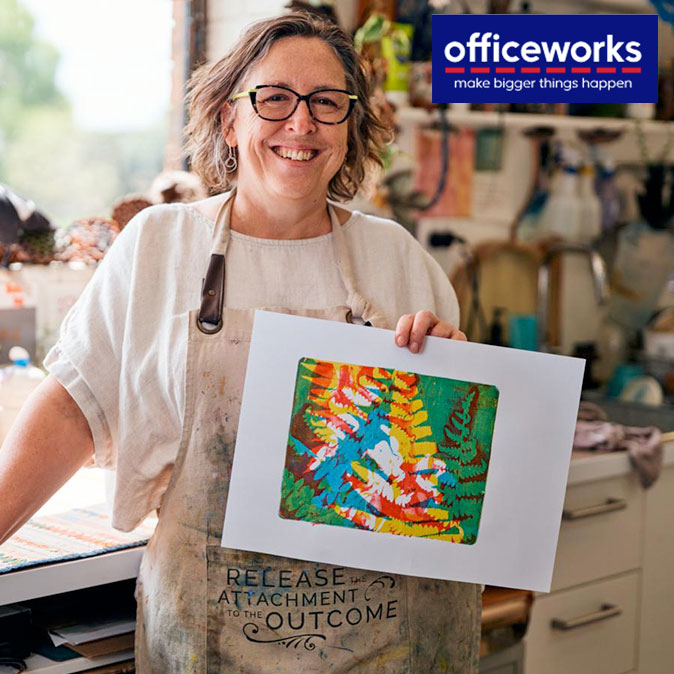How to Melt and Re-pour a Homemade Gelatin Printing Plate
Homemade gelatin plates are incredibly versatile, but after repeated use, they can become damaged, dirty and a bit tacky. Thankfully, you don’t need to toss them out—you can melt your gelatin plate down and re-pour it to bring it back to life! This process is simple, and with a few easy steps, your plate will be ready to use again.
Pictured above (left) is a plate I made back in August 2020, when I launched my first online Gelatin Plate Monoprinting workshop. I made the plate using my own DIY gel plate recipe.
Fast-forward 4 years, and my plate has definitely seen better days! She is in pieces. I don’t print with her often, as I have a large collection of commercial Gelli Arts plates, but she gets shown a lot at workshops. She is stored in the biscuit tray I first poured her into. As demonstration, I take the plate out of the tray and flop and flap her around to show how strong and flexible she is. Over time, tears started to appear, so I started to tear the plate into smaller pieces – great for some ‘jigsaw’ printing.
I think now it is time to melt her down and re-pour, to give her a new lease on life.
In this guide, I’ll walk you through how to melt and re-pour your homemade gelatin printing plate. Whether it’s damaged, worn out, or just needs a refresh, this technique will help you make the most of your printmaking materials.
If you’ve not made your own gelatin plate before, check out my easy DIY recipe. The recipe also shares tips and information about plate storage and DIY making troubleshooting tips.
Why Melt and Re-pour?
Over time, DIY and homemade gelatin plates will start to show signs of wear. Ink stains, surface marks and general wear can make printing difficult. My 4 year old plate started to develop a sticky surface, making it almost impossible to print with.
The good news is that by melting and re-pouring, you can restore the plate to a smooth, usable state. This process also allows you to reshape the plate if desired.
How to Melt and Re-pour Your Gelatin Plate
1. Prepare Your Gelatin Plate for Melting
Start by cutting your existing gelatin plate into small pieces—around 2cm x 2cm (1” x 1”) in size. This helps it melt evenly.
2. Melt the Gelatin Plate
Place the cut pieces into a microwave-safe bowl or double boiler and give the pieces about eight sprays of water from a water bottle sprayer.
Why the water? Over time, water naturally evaporates from the plate, which can affect its flexibility. Water can also evaporate during this melting process. Adding a small amount of water ensures that your re-poured plate remains supple and easy to work with.
There are two effective ways to melt your gelatin plate:
- Microwave Method: If you’re using a microwave, set it to low power and heat the bowl in 30-second intervals. Keep checking and stirring between bursts to make sure it melts evenly and doesn’t get too hot.
- Double Boiler Method: If you prefer more control or can’t adjust your microwave’s heat settings, use a double boiler on the stove. The gentle, indirect heat of the double boiler will slowly melt the plate without risking scorching or uneven melting.
Watch the Temperature: Make sure the gelatin melts at a low temperature. If it melts too quickly or gets too hot, it can become difficult to work with and high temperatures can affect the texture of the gelatin.
3. Pour
Once fully melted, pour the gelatin back into your mould. You can use the same mould or try a different one if you’re feeling creative. Make sure your mould is sitting level on your work surface, to ensure a nice level gelatin plate.
Tip: If there are any unmelted pieces or chunks left over (as there were in mine), pour the gelatin mixture through a fine-mesh strainer as you pour it in to the mould. Then discard the unmelted pieces.
4. Smooth
After pouring, use strips of newspaper to skim off any bubbles on the surface, just like when you originally made the plate.
5. Set and Cool
Let the plate set for at least an hour.
Once set, I like to placing my plate and mould in the fridge overnight. This helps it to shrink slightly, making it easier to remove from the mould.
If you’re in a hurry, you can begin using the plate in 2-3 hours once it has fully solidified.
How Many Times Can You Re-pour a Plate?
How many times you can melt and re-pour your plate will depend on how damaged it gets between melting. Generally, you can melt and re-pour your plate up to 3 or 4 times. However, you may notice that it gets a little stiffer with each re-pour. This happens because some of the water evaporates during the melting process, but the plate will still be functional for quite some time.
Final Thoughts
Melting and re-pouring a gelatin plate is a simple, eco-friendly way to extend the life of your materials. Whether it’s due to wear and tear or just the desire for a clean slate, you can keep using your homemade plates over and over with these straightforward steps.
Have you tried melting and re-pouring your plate? If yes, let me know in the comments how it worked for you!
And if you haven’t already, check out our full recipe for making your own gelatin printing plate.







Hi Kim,
My homemade Gelli plate became mouldy. I was thinking of adding a snall quantity of Isocol (alcohol) to the plate before or after meltingly to prevent a further problem. I am not sure if once you get mould that the plate can be reused? I would appreciate any tips or suggestions.
Hi Lynette, a few people have had the same problem. I’ve never had mould on my plate, and I live in a warm, damp, mouldy area. I’ve also never added isocol or other alcohol to my plate mixture. Can you scrape the mould off? if yes, keep using it. If no – can you cut it out, them melt and repour? Definitely worth giving that a go. I keep my plate stored in the mould I pour it into. It stays on an open shelf in my studio, on the inside wall where it tends to be drier than anywhere else. I also keep a hard plastic cover over it, to keep dust off the plate. What is the climate like where you are? cheers, Kim